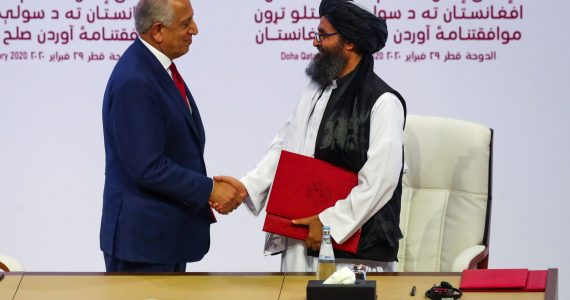
Difficulties in Afghan Peace Talks: From Regional Intervention to Intra-National Negotiations
Disclaimer: The views and opinions expressed in this article are those of the author and do not necessarily reflect the opinion of IFAIR e.V. or its members.
The 1979 Russian invasion of Afghanistan set in motion political instability and crises in the country that has seen no end ever since. In the ensuing war, millions were internally displaced and large numbers fled out of the country. The fall of the Soviet Union in 1989 was coupled with civil wars in Afghanistan which paved the way for Taliban’s Islamic Emirate to take over. After nearly four decades, Afghanistan still suffers from armed conflicts mainly spearheaded by the Taliban. The 1990s civil wars, the rise and fall of the Taliban and post 9/11 America’s operation in Afghanistan need to be analyzed when we evaluate peace talks between the Afghan government and the Taliban. This article highlights the problems of peace talks with the Taliban by setting the spotlight on hindering factors like internal divisions in Afghanistan, the role of regional states, and their relationships with and supports of the Taliban.
Official efforts for negotiations with the Taliban have at least 10 years of history, with its ups and downs. Hamid Karzai, former president of Afghanistan, established the High Peace Council (HPC) in 2010 in order to facilitate direct talks with moderate elements of the Taliban. The efforts made by Hamid Karzai’s administration allowed for the establishment of an office by the Taliban in Qatar in 2013 in an effort to initiate direct talks with the Afghan Taliban. After this office posed as the Islamic Emirates Embassy with a Taliban’s white flag erected on its walls, the government side withdrew from the process and called for its closure. In July 2015, Mullah Mohammad Omar, the leader of the Taliban group purportedly backed the peace talks with the Afghanistan government and called negotiations a legitimate way of ending foreign invasion in Afghanistan. In August 2015, Afghanistan’s National Security Directorate formally confirmed the death of Mullah Omar. The Taliban announced Mullah Mansoor as his successors and disavowed the peace talks after their leader’s death. Since 2015, the National Unity Government (NUG) has built on earlier efforts to bring the Taliban to the negotiation table as well as to build global, regional and national consensus for the peace process in Afghanistan. Nevertheless, it failed to generate any substantial results. The Taliban continue their violent destruction by constantly attacking city centers, highways, military corps, government offices, and more.
The Taliban have even made bold attempts to capture provincial centers. In 2015, the Taliban overrun the capital city of Kunduz, a strategic northern province, for the first time since they were removed from power in 2001.They overrun Kunduz once again in 2016. In May 2018, the Taliban came close to capture the provincial center of the western Farah province and recently, in August 2018, they coordinated a heavy attack on the strategic province of Ghazni. These events show that the Taliban were least interested in peace talks and negotiations during the tenure of the NUG. The group rejected ceasefire with the Afghan government and instead insisted on having direct talks with the United States.
There are complex problems in the peace process in Afghanistan that bear the potential to undermine the success of the process. Unless addressed, these factors can stymie the process at any point.
Regional Actors:
First, many Afghan officials emphasize that the Taliban are not an independent armed group capable of negotiating with the Afghan state. The Taliban are supported by different regional countries, mainly Pakistan and Iran; both main players in fueling the war in Afghanistan. In 2016, the group leader Mullah Mansoor visited Iran and while crossing the border to Pakistan was killed by a U.S drone strike. Iran’s support for the Taliban could be rationalized by three main reasons: Countering ISIS Khurasan (Afghanistan), complicating the longest war in U.S history and having control over water resources in Afghanistan. According to reports, Iran provides the Taliban with Ak-47 assault rifles and facilitates cash transfers in near border areas. It also provides a safe haven (probably training facilities) for the Taliban’s leadership councils.
Pakistan’s political and strategic support goes back to the rise of the Taliban during the 1990s civil wars in Afghanistan. Pakistan created the Taliban with the supports from the gulf countries. Intern-Service-intelligence (ISI) trained Taliban’s fighters which overthrew the Mujahidin government in 1996. According to Peter Thomsen, the former US Envoy to Afghanistan, Islamabad still uses the Taliban to pursue its interest in the region. A spokesperson of the Afghan Ministry of Interior Affairs claimed that Pakistan’s military was involved in the coordinated attack on Ghazni last August and provided all the needed assistance to the Taliban. On 15 March 2019, the Prime Minister of Pakistan said that “peace in Afghanistan is around the corner”. This was followed by reactions of Afghan diplomats criticizing what they called direct interference into Afghanistan’s domestic affairs. Further, Khan added: “A good government will be established in Afghanistan, a government where all Afghans will be represented. The war will end and peace will be established there.” Such statements had taken place side by side to the U.S.-Taliban peace talks in Qatar, headed by United States special representative Mr. Zalmay Khalilzad and a Taliban leader. Since 2014, several high-level visits have taken place between Afghanistan and Pakistan to discuss this in the hope of an agreement for cooperation, but these efforts had yielded no concrete results until recently.
Recently, on 29 February 2020, the U.S. and the Taliban signed a deal “for bringing peace to Afghanistan”. Soon after, the U.S. conducted an air strike against the Taliban for the support of Afghanistan National Defense and Security Forces. On the Afghan side, President Ashraf Ghani declined the release of 5000 Taliban prisoners before “Intra-Afghan” dialogue started. Only days later, he issued a decree on releasing Taliban prisoners under the conditions that they would not return to frontlines. Mechanisms to ensure this remain unclear as the decree only requires a written pledge from the Taliban prisoners.
High level officials from Pakistan and Iran saw the deal as an intervention into Afghanistan’s domestic affairs and Afghan officials said that regional consensus on peace in Afghanistan is still lacking. A recent joint statement by the U.S. and Russia hints support for “Intra-Afghan” negotiations by making clear that the Islamic Emirate of Afghanistan will not be recognized and accepted by any parties. This emphasizes that global powers have a stake in the process and its aftermath, making the whole situation even more complex.
Domestic Divide:
In addition to the regional factors, the lack of a consensus at national level on the peace process with the Taliban is yet another hindering factor. Domestic division is fueled by the lack of consensus on the agenda of peace talks with the Taliban, on the negotiating team, and on the strategy of the Afghan government in the negotiations. Furthermore, these divisions are exacerbated by a controversial election whose results have dragged the country to the brink of disintegration. Two presidents have sworn the oath of office, each calling the rival illegitimate. These divides definitely spillover in the peace talks, particularly given that such talks are strained by tight deadlines carved out in the US-Taliban agreement.
Conclusion:
With such severe problems, the road to bring peace in Afghanistan will be long and complicated, though not impossible. The past experiences indicate that negotiations may take place between the government and the Taliban. But making all the players in this multi-dimensional conflict happy will be greatly time consuming, putting the past achievements in Afghanistan in jeopardy. Achieving sustainable peace in Afghanistan is complicated. It needs a strong national government and national, regional and global consensus coupled with bringing the Taliban and the Afghan government to one table.
Bibliography
- Azizi, Sabera. 2018, Pakistan and Iran Keep Fueling Taliban Terror Tactics: https://nationalinterest.org/blog/middle-east-watch/pakistan-and-iran-keep-fueling-taliban-terror-tactics-27482
- https://en.wikipedia.org/wiki/Afghan_High_Peace_Council
- Laub, Zachary. 2014, the Taliban in Afghanistan: https://www.cfr.org/backgrounder/taliban-afghanistan
- Kay, Johnson. 2015, Taliban disavows Afghan peace talks after leader declared dead, full text: https://www.reuters.com/article/us-afghanistan-taliban-fighting/taliban-disavows-afghan-peace-talks-after-leader-declared-dead-idUSKCN0Q40DW20150730
- Salehi, Nasir. 2018, Russia and Iran ‘ordered’ Taliban to destroy schools, mosques: https://afghanistan.asia-news.com/en_GB/articles/cnmi_st/features/2018/08/17/feature-01
- https://worldview.stratfor.com/article/iran-taliban-islamic-state-khorasan-afghanistan
- https://foreignpolicy.com/2020/03/04/us-taliban-peace-deal-under-fire-kabul-dispatch/
- https://www.npr.org/2020/03/06/812924960/despite-bloody-week-in-afghanistan-u-s-pushes-taliban-peace-talks-forward
- https://www.reuters.com/article/us-afghanistan-taliban-opening/afghan-taliban-opens-qatar-office-says-seeks-political-solution-idUSBRE95H0NU20130618

Abbas Azimi
Abbas Azimi is currently working as a peace activist, independent researcher and with the Government of Afghanistan. He holds a Bachelor Degree in Political Science from the Sharidhar University and a Master Degree from the Department of Conflict Resolution and Peace Building at Jamia Millia Islamia University.
